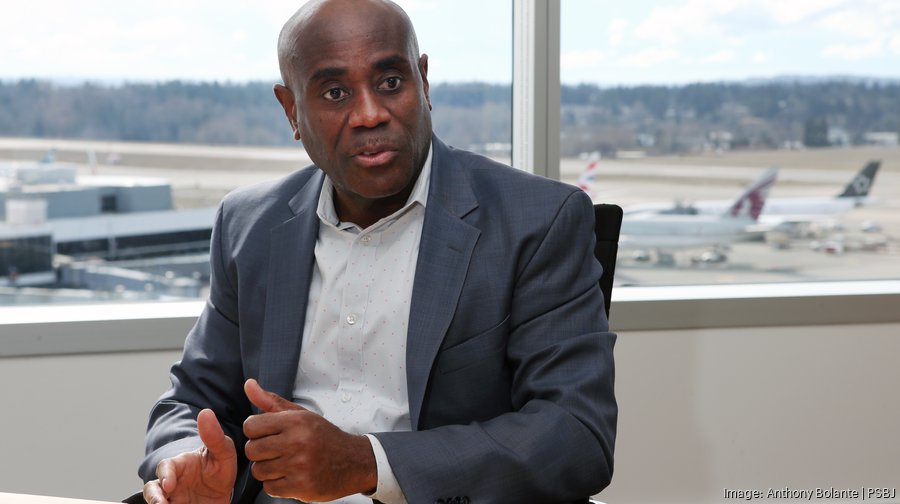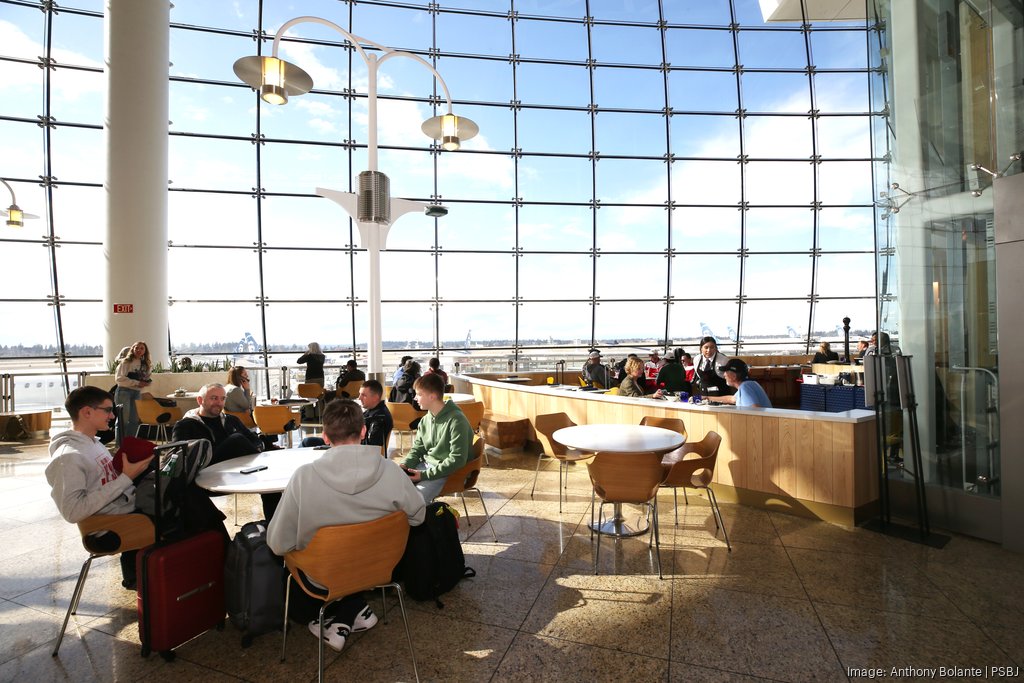Discussion:
Seattle-Tacoma International Airport has cut the ribbon on nearly $2 billion worth of major capital projects in the last two years, but much more remains on its to-do list.
The airport is looking ahead to another roughly $5 billion in updates through 2027.
That’s in an effort to manage what’s now elevated demand throughout the week, with fewer peaks and valleys than before, Charles Goedken, manager of operational readiness and airport transition, said at a presentation in the airport’s Conference Center in mid-June.
“We can’t build or improve the airport fast enough to keep up with that growth and still stay operational,” he said.

Here’s a look at projects recently completed and underway at Seattle-Tacoma International Airport. Photos by Anthony Bolante | PSBJ
Sea-Tac Airport mega-projects: Scroll to the bottom to see a breakdown of budgeted projects.
Nearly 46 million passengers flew through Sea-Tac Airport last year, up over 27% from 2021. Though the airport doesn’t expect to exceed 2019’s pre-pandemic traffic this year, it could hit that milestone in 2024.
Recently completed projects include the International Arrivals Facility, Central Terminal renovation and expanded N Concourse. Project costs could still rise once fixes for the arrivals facility, which was found to have design flaws, get underway.
‘We have to get it right the first time’
Lance Lyttle, Sea-Tac’s managing director, spoke to the Business Journal about the airport’s capital projects program before news of the arrivals facility surfaced in April. He said the airport has added more than a million square feet in the last few years despite being locked into a 2,500-acre footprint.
“We go up, we go in and in certain cases we actually go down,” he said.
Because of the space constraints, projects at Sea-Tac don’t have the same margin for error other airports have.
“When I worked in Houston, we had a lot of land, we could make a mistake,” Lyttle said. “We can’t do that here. We have to get it right the first time, because we don’t have any space to make any mistakes.”
Recent projects have aimed to create more open, airy spaces and bring more amenities and technological improvements to Sea-Tac. The airport has invested in road widening to decrease congestion, improved restrooms and increased accessibility, including hearing and vision assistance, said Julie Collins, director of customer experience and brand strategy.
But projects like the $546 million SEA Gateway Project, which the airport is undertaking with Alaska Airlines, have caused congestion problems of their own, Goedken said.
“We have to figure out how to make that work while keeping the passengers going,” he said, including making construction areas more navigable.
The airport has had to balance its infrastructure investments with new systems to keep screening-line wait times low, help customers find their way around, and connect them with revenue-generating retail and dining services. Improvements have included the introduction of new apps like Spot Saver, which allows customers to book a time to go through security checkpoints, and OrderSEA, for ordering food.
“We don’t have that space, so the way we can compete is through innovation,” Lyttle said. “We can compete through the level of service we can provide our customers.”
Such efforts have netted the airport high rankings from international airport rating company Skytrax the past two years. Sea-Tac aims to earn a rare five-star rating from the company, which only one U.S. airport, Houston’s William P. Hobby Airport, has secured.
Growing pains
Still, the airport’s growth has not come without setbacks.
Though it added eight new international-capable gates as part of its nearly $1 billion arrivals facility project, four of the gates are unable to accommodate widebody planes simultaneously, creating a potential capacity crunch. The issue could cost the airport hundreds of millions of dollars over the life of the facility, while fixes could cost at least $78 million, according to court filings stemming from a lawsuit against the general contractor.
The airport has time to find a solution
The arrivals facility was intended to address passenger growth over the next two decades, with the capacity to process up to 2,600 passengers per hour — much greater than the current international traffic through Sea-Tac. During its busiest travel periods so far this year, the airport has handled around 1,500 international passengers per hour, though that’s expected to increase somewhat during the summer travel season.
Before the addition of the arrivals facility, Sea-Tac could handle a maximum of 1,200 international passengers per hour, occasionally forcing flyers to wait on board for customs and hallways to clear or a gate to become available.
Forecasts created prior to the pandemic for the Port of Seattle, which oversees the airport, predicted international traffic would increase 38% overall in the next two decades, to around 3.95 million passengers annually. At around 2.19 million enplaned passengers last year, international traffic through the airport was still down more than 20% from its 2019 highs.
Even if the port winds up footing all or part of the bill for the fixes to the arrivals facility, the added costs won’t impact its current slate of capital projects, which are funded using bonds borrowed against the airport’s operating revenues from fees it charges airlines and its retail and dining tenants.
Sea-Tac expects to collect $801 million in revenue this year and allocate $663.9 million of that toward capital improvements. Using the bond funds, the airport will also spend around $1 billion per year in new construction over the next four years.
‘Revolving’ renovations
The new projects will bring some parts of the airport, built decades ago, up to modern seismic and building standards, as well as incorporate new safety and accessibility standards.
Behind and beneath the areas passengers see, the airport is also roughly halfway through a decadelong overhaul of its baggage-handling system, a $746 million effort that will unite six disparate systems into one and allow for improved screening and tracking from ticket counter through loading onto the plane. That project is expected to be completed by 2026.
“One measure of success, of course, is if you get it done within the schedule and budget. The more important metric of success is whether we can process” more passengers per hour, Lyttle said. “Because you can have a brand-new facility and it still doesn’t work any better than the old one.”
The renovations will continue to be a revolving project, Lyttle said, with enough work identified to keep construction crews busy for the next decade — after which the airport will go back to the drawing board.
“Any major airport you go to, by the time you finish one end, it’s 15 years later and the other part of the airport needs to be renovated,” he said.
Sea-Tac Airport mega-projects
The airport’s nearly $5 billion, five-year capital improvements budget includes five mega-projects totaling over $2.35 billion.
Here’s a snapshot of the airport’s largest projects in design or construction through 2027. The amounts reflect spending over the five-year budget period and may not include the entire project cost. The amounts are mostly from the Port of Seattle’s 2023 final budget, though the C Concourse and SEA Gateway budgets show updated budget amounts.
- Baggage optimization, $591.6 million: Replaces and reconfigures baggage screening equipment and operations. Finishes in Q3 2026
- C Concourse expansion, $340 million: Constructs three news floors atop the airport’s C Concourse building for offices, restrooms, passenger lounges and concessions. Finishes in Q2 2027.
- SEA Gateway (shared with Alaska Airlines), $546 million: Redevelops space at the north end of the main terminal ticketing level. Finishes in Q3 2026.
- S Concourse evolution, $674.3 million: Upgrades systems and public-facing areas. Estimated completion in 2031.
- Main terminal improvements, $200 million: Architectural and systems upgrades in coordination with SEA Gateway project. Currently in design.
Of the remaining $2.5 billion budgeted, more than half ($1.5 billion) is for other large projects, such as the utility master plan ($198 million), wastewater, stormwater and drainage improvements ($125 million), and airfield pavement replacement ($101 million).
Another $394 million is for 21 proposed new projects, plus there’s $263 million in reserve funds for “undefined future projects” or budget increases to existing projects.
